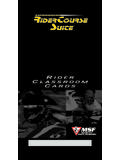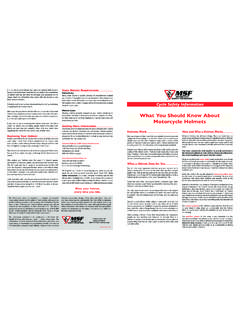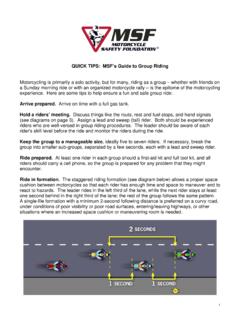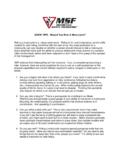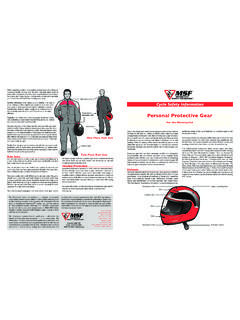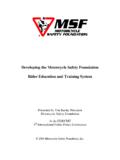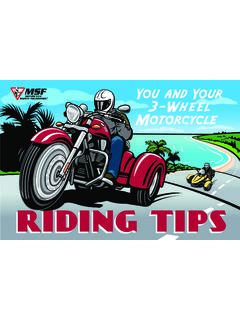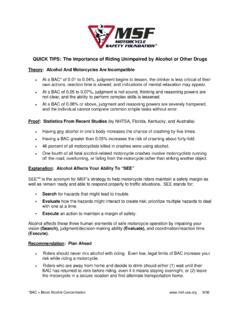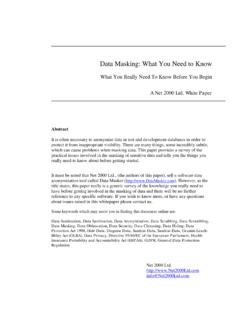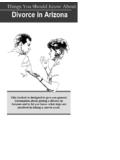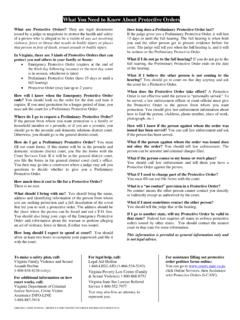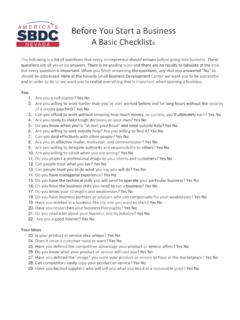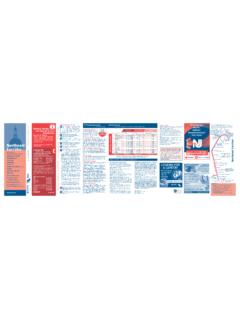Transcription of Helmet Laws What You Should Know About …
1 Helmets WorkMost sport-type activities have their own suitable protective gear and equipment. Motorcycling is no exception. Every rider and passenger Should wear over-the-ankle footwear, long pants, a long-sleeved jacket, full-fingered motorcycle gloves, and a Helmet manufactured to comply with DOT ( Department of Transportation) work. Helmet effectiveness has been confirmed by scientific studies, while Helmet myths helmets break necks, block vision and impair hearing have been consistently disproved. Safety-conscious riders wear helmets as a sensible, responsible choice every time they ride; we know that you will, a Helmet Does for YouFirst, it is the most important protective gear you can wear while riding a motorcycle.
2 Think of it at the same time you think of your ignition key: Pick up the key; pick up the Helmet . They go together. Helmet use is not a cure-all for motorcyclist safety, but in a crash, a Helmet can help protect your brain, your face, and your life. Combined with other motorcycle-specific protective gear, rider-education courses, proper licensing and public awareness, the use of helmets is one way to reduce hope your Helmet never has an impact. But crashes do happen. We can't predict when or what kind they will be. You Should not say to yourself, I'm just running down to the store, and not wear your Helmet .
3 Second, a good Helmet makes riding a motorcycle more fun, due to the comfort factor: another truth. It cuts down on wind noise roaring by your ears, on windblast on your face and eyes, and deflects bugs and other objects flying through the air. It even contributes to comfort from changing weather conditions and reduces rider , wearing a Helmet shows that motorcyclists are responsible people; we take ourselves and motorcycling seriously. Wearing a Helmet , no matter what the law says, is a projection of your attitude toward riding. And that attitude is plain to see by other riders and non-riders and Why a Helmet WorksDifferent helmets do different things.
4 There are hard hats on construction and heavy-industry heads; football helmets on athletes heads, and Kevlar caps on military heads. None are interchangeable. Motorcycle helmets are very sophisticated and specialized for the activity. They've been developed carefully and scientifically over the basic components work together to provide protection in the motorcycle Helmet : an outer shell; an impact-absorbing liner; the comfort padding; and a good retention we see first is the outer shell, usually made from some family of fiber-reinforced composites or thermoplastics like polycarbonate. This is tough stuff, yet it's designed and intended to compress when it hits anything hard.
5 That action disperses energy from the impact to lessen the force before it reaches your head, but it doesn't act alone to protect the shell is the equally important impact-absorbing liner, usually made of expanded polystyrene (commonly thought of as Styrofoam). This dense layer cushions and absorbs shock as the Helmet stops and your head wants to keep on the shell and the liner compress if hit hard, spreading the forces of impact throughout the Helmet material. The more impact-energy deflected or absorbed, the less there is of it to reach your head and brain and do damage. Some Helmet shells delaminate on impact. Others may crack and break if forced to take a severe hit; this is one way a Helmet acts to absorb shock.
6 It is doing its intended job. Impact damage from a crash to the non-resilient liner may be invisible to the eye; it may look normal, but it may have little protective value left and Should be comfort padding is the soft foam-and-cloth layer that sits next to your head. It helps keep you comfortable and the Helmet fitting snugly. In some helmets, this padding can even be taken out for retention system, or chin strap, is very important. It is the one piece that keeps the Helmet on your head in a crash. A strap is connected to each side of the shell. Every time you put the Helmet on, fasten the strap securely. It only takes of couple of seconds.
7 To ride without your Helmet secured would be as questionable as driving without your seatbelt Safety InformationWhat You Should know About Motorcycle HelmetsThe Motorcycle Safety Foundation is a national, not-for-profit organization promoting the safety of motorcyclists with programs in rider training, operator licensing and public information. For the Basic or Basic RiderCourse2 - License Waiver nearest you, call the national toll-free telephone number: (800) 446-9227. The MSF is sponsored by the distributors and manufacturers of BMW, BRP, Ducati, Harley-Davidson, Honda, Kawasaki, KTM, Piaggio, Polaris Motorcycles, Suzuki, Triumph and Yamaha information contained in this publication is offered for the benefit of those who have an interest in riding motorcycles.
8 The information has been compiled from publications, interviews and observations of individuals and organizations familiar with the use of motorcycles, accessories and training. Because there are many differences in product design, riding styles; and federal, state and local laws, there may be organizations that hold differing opinions. Consult your local regulatory agencies for information concerning the operation of motorcycles in your area. Although the Motorcycle Safety Foundation will continue to research, field test and publish responsible viewpoints on the subject, it disclaims any liability for the views expressed October 20142 Jenner, Suite 150 Irvine, CA 92618(949) 727-3227 is not wise to store helmets near gasoline, cleaning fluids, exhaust fumes, or excessive heat.
9 These factors can result in the degradation of Helmet materials, and often the damage goes unnoticed by the wearer. Read the information that comes with the Helmet so you know how to care for read the instructions About painting, decorating, pinstriping, or applying decals to your you take your Helmet off, find a flat, secure place for it. You could set it on the ground, secure it on a rack, or stow it on a shelf. On some bikes, putting it on the fuel tank may expose it to fumes. If you place it on the seat, make sure it won't fall you plan to use a communication device when you ride, find a model that doesn't require drilling speaker holes in the outer shell.
10 Before you purchase your speakers, check with your state's laws regulating their use in helmets. Some states prohibit Your Helmet Replace your Helmet if it was involved in a crash; it probably absorbed some impact shock. Some Helmet manufacturers will inspect and, when possible, repair a damaged Helmet . If you drop your Helmet and think it might be damaged, take advantage of this Helmet manufacturers recommend replacing your Helmet every few years. If you notice any signs of damage before then, replace it replace your Helmet every few years if it doesn't appear damaged? Its protective qualities may deteriorate with time and wear.
